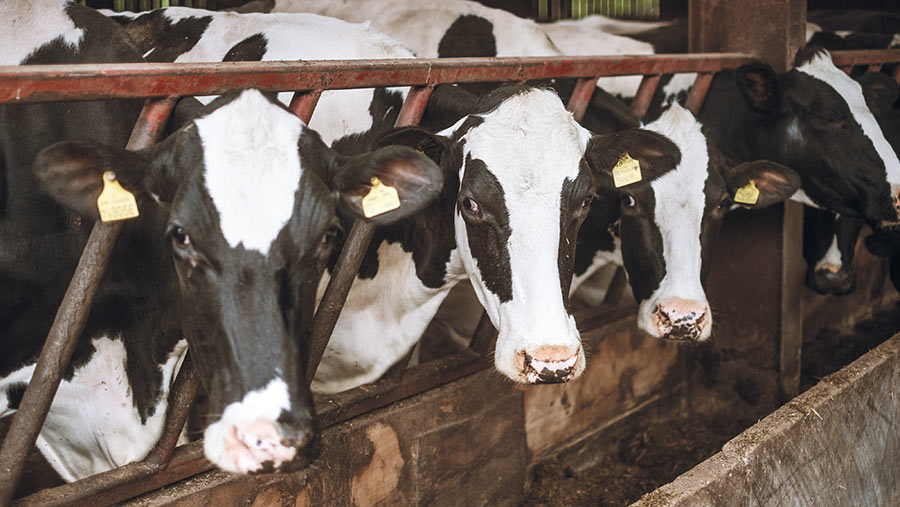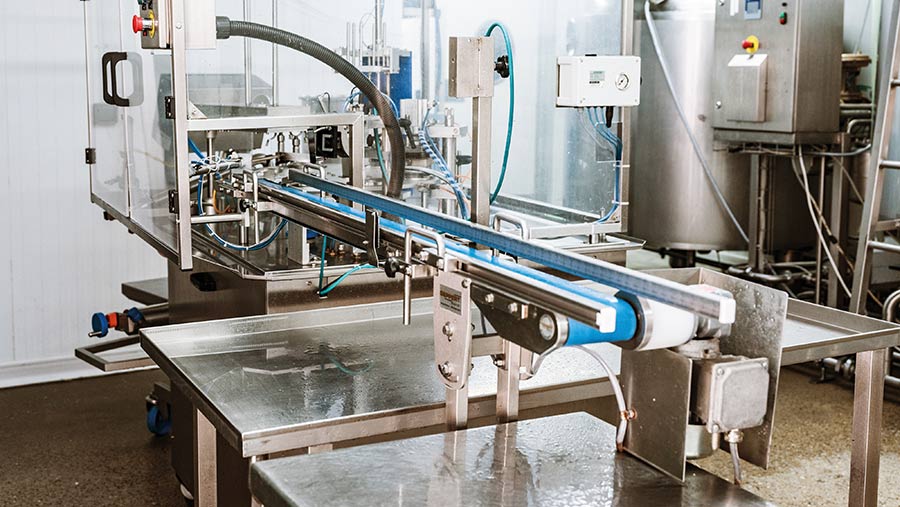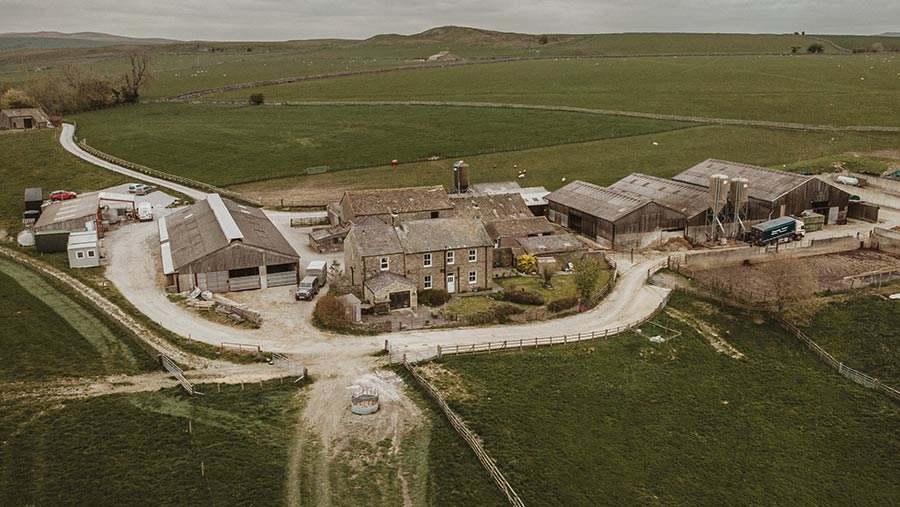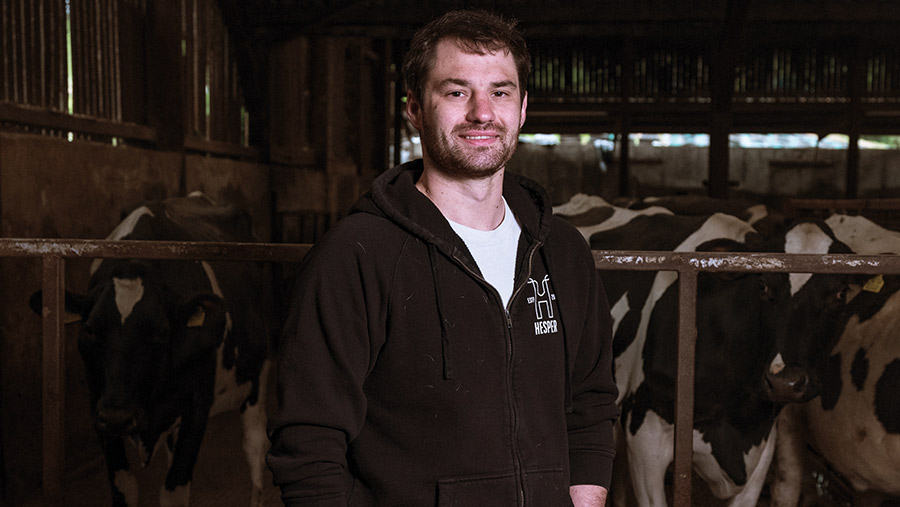Video: How Icelandic yogurt adds value to a dairy farm
 © MAG/Colin Miller
© MAG/Colin Miller On-farm skyr production has raised the value of milk on a Skipton dairy unit to £1/litre.
The change in direction at the 137ha (340-acre) dairy farm on the edge of the Yorkshire Dales came in 2015 amid continued uncertainty in the milk market, and a crash in prices.
Third-generation farmer Sam Moorhouse, who farms with his father, Brian, says the move was a bid to secure the long-term future of Hesper Farm, home to the award-winning pedigree Holstein Aireburn herd.
See also: Dairy farm diversifications attract new custom
“We were in the position – which a lot of people found themselves in at that time – of talking about whether we needed to scale up to make it work, or how we could make more from what we had,” he says. “Ultimately, that is what led to the diversification into skyr.
“The idea was that we could make more from the milk we produce.”
Farm facts
Hesper Farm, Bell Busk, Skipton, Yorkshire
- 137ha (340 acres)
- 170 head pedigree Holsteins
- Calves year-round, rears own replacements
- Surplus reared until first calving, and then sold as breeding stock at market
- Butterfat: 4.2%
- Protein: 3.2%
Watch the video and read the rest of the report below.
What is skyr?
Skyr is Iceland’s traditional dairy product made from skimmed milk, skyr cultures and vegetarian rennet to create a thick, yoghurt-like product that is high in protein and fat-free.
Milk is heat-treated and combined with the other ingredients, which turns it into a curd. The curd is then broken, and the whey strained out until it is very thick.
About 3.3 litres of skimmed milk is required to make 1 litre of skyr.
Source: Sam Moorhouse
Diversification opportunities
Because the farm was already producing high-fat, high-protein milk, diversifying into products such as cheese, ice cream and yoghurt was a natural fit, he explains.
“But, for me, if we were going to diversify, it had to be a little bit different – there’s a lot of ice cream out there and many people doing it really well. We needed to have a point of difference.”
Skyr is now readily available on supermarket shelves, but when he decided to diversify, not even Sam had sampled it.
“I was reading an article about Icelandic dairy production, and it mentioned it [skyr] in there. I did a bit of research and found out it was a high-protein yoghurt from Iceland, and it just seemed to fit the market trends at the time.
“Everyone was talking about high-protein [products] then – and still are now. No one else was really doing it at the time, either.”

© MAG/Colin Miller
Investment
With the idea in motion, Sam’s next move was to visit Iceland to learn more about how to make skyr. Once there, he had his first taste of the product, and met a producer willing to show him the production process.
Back home, and confident in his idea, he set about the construction of the dairy plant.
“The first step was securing some finance, as it was quite expensive to get started – about £200,000.
“It is a hell of a lot of money, especially in farming at that time, when we were under pressure. We got bounced back quite a bit.”
But after doing more in-depth business planning and forecasting, the farm was able to secure the funds, and converted an old 120sq m calf shed into what is now the Hesper dairy.
Specialist equipment such as holding tanks and vessels, heat treatment units and potting machines then had to be sourced.
The process, from start to potting the first skyr at Hesper Farm, took about six months, he says.
Reflecting on his learnings from Iceland, producing a high-quality, authentic product was also important, says Sam, so conducted some trials at Reaseheath College to perfect his recipe.

© MAG/Colin Miller
Markets
Hesper skyr is sold to local farm shops and restaurants, and has had success with national retailers, including Morrisons and Waitrose.
Expanding this customer base further will be a focus over the coming years, he says.
On the shelf, a 450ml pot of natural skyr retails at £2.25, and the flavoured types at £2.50. He reckons the value of the farm’s milk now averages about £1/litre.
“Having control over the price shields us from the ups and downs [of selling to a processor].”
As skyr is made with skimmed milk Sam has secured a local market, Dales Dairies, for the cream taken from the milk, as well as any surplus litres.
This ensures he gets the best margin from every litre of milk produced.
As skyr was a relatively new product at the time, one of his biggest challenges was marketing the product and educating consumers about what it is.
However, launches of skyr products by Arla and other big brands at about the same time really helped to drive consumer interest and demand, he says.

© MAG/Colin Miller
Herd management
The simple setup of the dairy herd means the two enterprises can run symbiotically, says Sam, and no changes to the herd management were needed to facilitate the diversification.
“We’ve always bred for a strong cow that can live for a long time, have multiple lactations and is self-sufficient. It works well for the farm and the skyr business.”
While Sam manages the skyr business along with five employees, Brian oversees the running of the herd, alongside two full-time staff.
The herd operates on a predominately grass-based system. Cows graze through the summer – usually going out after first cut – and are housed during the winter on a deep bed of sawdust.
They are fed a partial total mixed ration consisting of silage, caustic soda and brewers’ grains. Three cuts of silage are taken a year.
Brian says there is no desire to move away from Holsteins anytime soon. “I like everything about the breed. I like the diversity of the gene pool and the temperament is better.
“For us, they are the ideal cow. The breed is always evolving, but at the moment I’d say the Holstein breed has never been better.”
Now the skyr business has found its feet, Sam says he will be getting more involved with the herd management once again to ensure both remain viable in the future.
“With rising feed costs, we’re looking to reduce our bought-in feed and make even more of the forage,” he adds. “We just try to do the basics well.”
Future plans
Having made a name for themselves in the world of skyr, Sam has ambitions to expand Hesper’s product range further.
“We are just about to launch a new brand called Bell Busk Farm with Bupa hospitals,” he says. “We’re going to be supplying all of their hospitals and care homes with branded yoghurt.”
Sam Moorhouse’s top tips for skyr success

Sam Moorhouse © MAG/Colin Miller
- Do the maths early on and ensure you understand the true cost of the operation
- Invest in good branding
- Understand and be specific about the market you are trying to target
